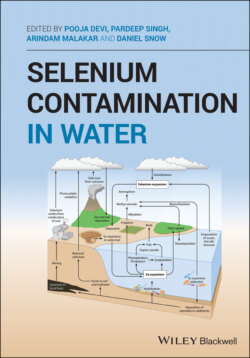Читать книгу Selenium Contamination in Water - Группа авторов - Страница 27
2.4 Interaction of Selenium with Organic Matters and Microorganisms
ОглавлениеIn combination with other naturally occurring ecological conditions, organic matters (OM) have also play a vital role. It has been reported that Se interacts with OM in soil and aquatic environments (Abrams et al. 1990; Zhang and Moore 1996). The distribution coefficient (Kd) for Se‐OM is 1800 l/kg which is twice that for Se to soil clay. This association of Se‐OM governs the mobility of Se species by complexation process (Filella and Town 2003). In soil and water the high heterogeneity of OM (Sutton and Sposito 2005) makes it more complex to study the properties of OM because of the occurrence of higher OM content in top soil; Se concentration is high in surface soil as compared to deeper soil layers (Zhang and Moore 1996).
Ferri and Sangiorgio (2001) have studied the interaction of selenite with natural polysaccharides of different molecular weight. The studies revealed that the charge on organic species doesn't affect the formation constants but its strength is dependent on the structure of the complex. It has been reported that Se binds well with OM in acidic soils (Christensen et al. 1989; Gustafsson and Johnson 1992). Interaction with humic and fulvic acids has been studied and correlated with animal (Wang et al. 1996) and plant uptake (Kang et al. 1991; Zhang and Moore 1996). The interaction of Se species with fulvic acid (soluble) is more bioavailable than humic acid (suspended particulate) (Qin et al. 2012). This can be explained by the retention of negatively charged oxyanions by the OM that immobilizes the Se species in anoxic conditions. The study of interaction of selenium oxyanions and humic acid has been carried out in by Bruggeman et al. (2005, 2007). The interaction of inorganic Se with humic acid as well as with plants and microbial processes may immobilize Se (Tolu et al. 2014) and make them less bioavailable. In the presence of reducing phase (e.g. FeS2), selenate is expected to reduce to selenite which is removed by precipitation (Bruggeman et al. 2005). This elemental Se can be further altered to ferroselite (FeSe2) inside the sediments by precipitation reactions or by assimilation into solid phases (e.g. pyrite) (Velinsky and Cutter 1991). FeSe2 on oxidation can be converted to selenate according to the reaction (Eq. 2.1) (Bailey et al. 2012).
Gustafsson and Johnson (1992) have reported that considerable amount of Se fractionation is present in OM rich Bs horizon of Swedish podzols due to the high adsorption capacity of anions by OM. Wang and Gao (2001) have reported that despite having sufficient Se concentration (0.1–0.3 μg/g) in soils, Keshan and Kashin –Beck diseases (Se deficiency) are widespread in the northeastern regions of China. This is because the soil is rich in OM. This result in immobilization of Se and makes it less bioavailable. Se concentration in wetland soils (Cooke and Bruland 1987; Thompson‐Eagle and Frankenburger 1992) and evaporation ponds (Fan and Higashi 1998) also depends on biogeochemical volatilization of Se.
In the environment, reduction of dissolved Se oxyanions to particulate Se in oxygenated water occurs via plant uptake and by microorganisms and affects Se bioavailability. Through a dissimilatory reduction (energy metabolism) process microorganisms can use soluble selenate (SeO42−) and selenite (SeO32−) as electron acceptors and reduce to insoluble and less bioavailable Se(0) or Se(‐II) species. In this process SeO32− acts as an intermediate. These insoluble Se(0) and Se(‐II) are further transformed to volatile organic‐Se species and escape to the atmosphere. Hamdy and Gissel‐Nielsen (1976) have studied under laboratory conditions and reported that the volatilization of reduced Se is higher in sandy soil than a humic soil which is about 8 and 5% of added Se, respectively. The selenate owing to its kinetically inert nature does not get precipitated and remains in equilibrium with other selenium species formed in soil or ground water that are rich in humic acid. The following reactions (Eqs. 2.2 and 2.3) for the reduction of Se oxianions to elemental Se have been reported by Bailey et al. (2012) with the generic carbon species:
(where CH2O represents generic organic carbon compound).
This process provides an efficient way for detoxification of environment as insoluble Se and organic‐Se compounds are less toxic than soluble Se oxyanions (Bailey et al. 2012). Appropriate electron (e−) donor substances such as sugars, alcohols, humic substances, organic acids and hydrogen (Bailey et al. 2012; Korom 1992) have been used by Se‐reducing microorganisms. Se oxyanions are behaved as electron (e−) acceptor in dissimilatory reduction reactions. Dissimilatory reduction process contributes significantly to detoxification of a seleniferous environment as compared to the assimilatory reduction process. Dissimilatory reduction offers a cost‐effective way for environmental remediation and therefore attracts the attention of researchers. Eswayah et al. (2016) have reviewed in detail the microbial transformations of unlike forms of Se, assimilation, dissimilation reduction process, anaerobic respiration of several microorganisms supported by dissimilatory reduction, formation of nanoparticulate elemental selenium, etc. Retention of Se by cattle manure has also been reported by Ogaard et al. (2006). In the batch studies the group observed that on addition of cattle manure there is a decrease in adsorption of both selenite and selenate to a loam soil, since manure contains organic acids of low molecular weight such as acetic, formic, and oxalic acids which contend with Se for available sorption sites (Ogaard 1996).
